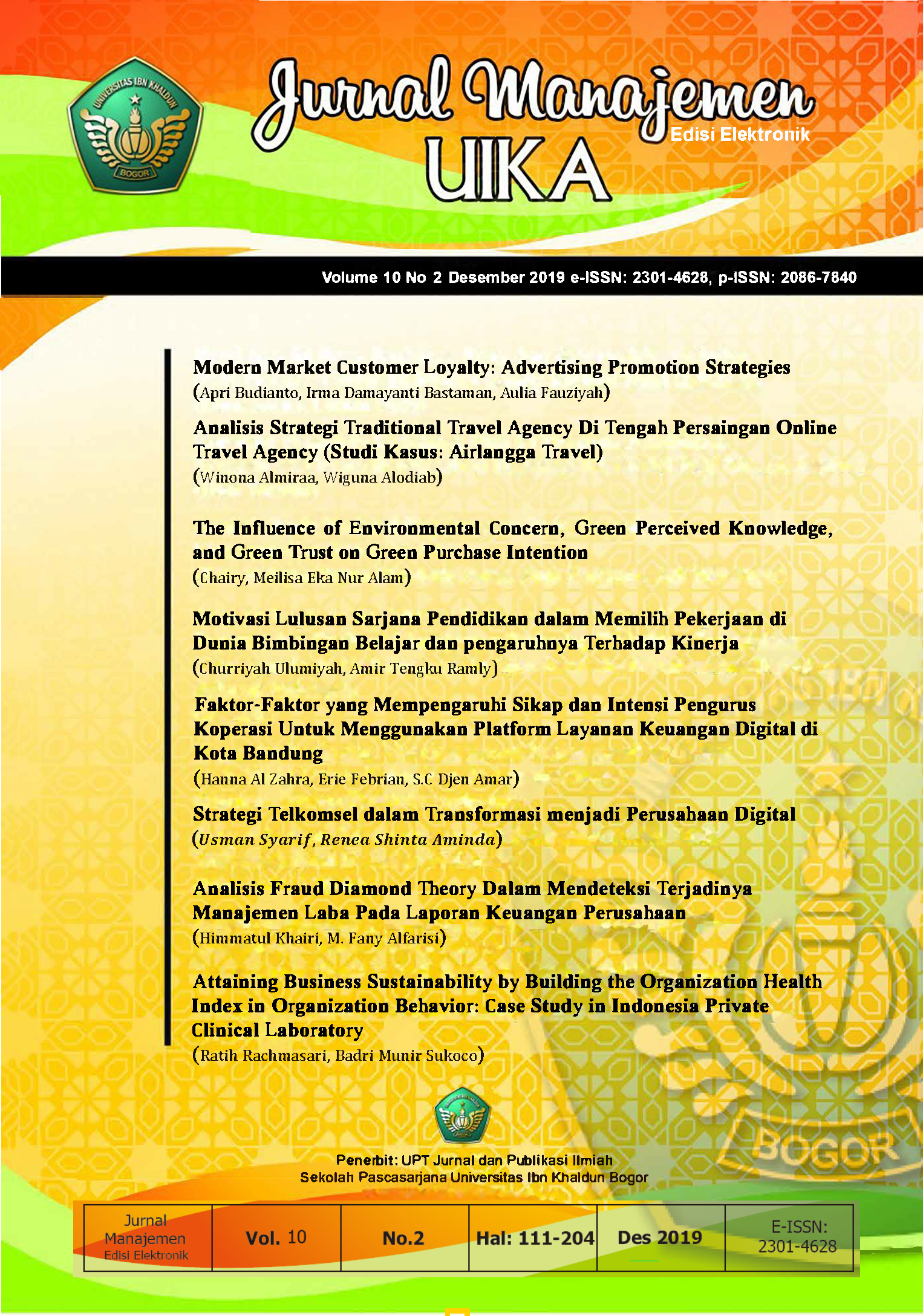Analisis Fraud Diamond Theory dalam Mendeteksi Terjadinya Manajemen Laba pada Laporan Keuangan Perusahaan
DOI:
https://doi.org/10.32832/jm-uika.v10i2.2552Keywords:
Fraud, Fraud Diamond, Earnings management, Financing FirmAbstract
In this paper, we discuss the elements of fraud diamond theory against indications of earnings management in Indonesia's financing firms for the year 2014 to 2018. The independent variables are financial stability, institutional ownership, audit quality, effective monitoring, auditor changes, ratio total accruals to total assets, change of directors, and independent board of commissioners, while the dependent variable used is the manipulation of financial statements proxied by earnings management. This study used 75 samples taken from 15 companies listed on the Indonesia Stock Exchange in 2014-2018. This research was conducted with quantitative methods using secondary data. Data analysis uses multiple regression models based on panel data, using firm size, leverage and firm age as a control variable. The results indicate that there are three important variables in the analysis of financial manipulation, those are financial stability, ratio total accruals to total assets, and a number of independent commissioners. These variables represent three elements in the diamond fraud theory, financial stability which is presenting pressure, ratio total accruals to total assets representing rationalization, and a number of independent commissioners presenting competency.References
ACFE, (2018). Report to The Nation on Occupational Fraud and Abuse (On-line).Diakses 14 Juni 2019
Beasley, M., & Salterio, S. (2001). The relationship between board characteristics and voluntary improvements in the capability of audit committees to monitors. Contemporary Accounting Research, 18(4).
Beneish, Messod. (1999). The Detection of Earning Manipulation. Financial Analysis Journal. Vol 55, No. 5.
Cressey, D. (1953). Other Peoples Money: A Study In The Social Physhology Of Embezzlement. IL: Free Press
Dechow, P., Sloan, R. & Sweeney, A. (1995).Detecting earning management. The Accounting Review
Dorminey, J., Fleming, A. S., Kranacher, M. J., & Riley, R. A. (2012). The evolution of fraud theory. Issues in Accounting Education, 27(2), 555579
Farvaque, E., Refait-alexandre, C., & Sadane, D. (2012). Corporate Disclosure?: A Review Of Its ( Direct And Indirect ) Benefits And Costs. International Economics, 128(2011).
Francis, J. R., and Krishnan, J. (1999). Accounting accruals and auditor reporting conservatism.Contemporary Acconting Research, 16(1).
Francis, J. R. (2004). What do we know about audit quality??.The British AccountingReview,36 (4).
Hogan, C. E., Rezaee, Z., Riley, R. A., & Velury, U. K. (2008). Financial statement fraud: Insights from the academic literature. Auditing, 27(2).
Healy, P. M., & Palepu, K. G. (2001). Information asymmetry , corporate disclosure , and the capital markets?: A review of the empirical disclosure literature
Healy, P. M., & Wahlen, J. M. (1999). A Review of the Earnings Management Literature and Its. Accounting Horizons, 13(4).
Jensen, M. & Meckling, W. (1976). Theory of the firm: Managerial behavior, agency costs and ownership structure. Journal of Financial Economics, 3(4).
Lennox, C., Pittman, J. (2010). Big Five Audits and Accounting Fraud.Contemporary Accounting Research,Vol 27, No1.
Leuz, C., Nanda, D. Wysocki, P.D. (2003). Earnings Management and Investor Protection: An International Comparison.Journal of Financial Economics, Vol. 69. No. 3.
Loebbecke, J., Eining M., and Willingham J. (1989). Auditors Experience With Material Irregularities:Frequency, Nature, and Detestability.Auditing: A Journal Of Practice and Theory 9(1).
Lou, Y. I., & Wang, M. L. (2009). Fraud Risk Factor of The Fraud Triangle Assesing The Likelihood of Fraudulent Financial Reporting. Journal of Business and Economic Research.
Rezaee, Z. (2002). Financial Statemen tFraud: Prevention and Detection. New York: John Wiley &Sons, Inc.Sons, Inc.
Ruankaew, T. (2016). Beyond the Fraud Diamond. International Journal of Business Management & Economic Research, 7(1), 474476.
Schipper, K. 1989. Commentary on earnings management. Accounting Horizons (December): 91102.
Scott, W. (2009). Financial Accounting Theory.Toronto: Prentice Hall
Sekaran, Uma. (2003). Research Methods for Business. 4 Edition. John Wiley & Sons Inc. Terjemahan Kwan Men Yon. Metodologi Penelitian Untuk Bisnis (Edisi 4). Jakarta: Salemba Empat.
Skinner, D. J., & Dechow, P. M. (2000). Earnings Management: Reconciling the Views of Accounting Academics, Practitioners, and Regulators. Accounting Horizons, 14(2).
Skousen, C. J., Smith, K. R., & Wright, C. J. (2008). Detecting and predicting financial statement fraud: the effectiveness of the fraud traingle and, (99).Corporate Governance and Firm Performance Advance in Financial Economincs, Vol. 13
Statement of Auditing Standards (SAS) No.99 Tahun 2002
Stice, J.D. (1991).Using Financial and Market Information to Identify Preengagements Factors Associated with Lawsuits Against Auditors.The Accounting Review (July).
Summers, S. L., & Sweeney, John, T. (1998). 1998 Fraudulently Misstated Financial Statements and Insider Trading copy.pdf. The Accounting Review, 73(1), 131146.
Tessa, Chyntia G.,Puji Harto.(2016). Fraudulent Financial Reporting: Pengujian Teori Fraud Pentagon Pada Sektor Keuangan Dan Perbankan Di Indonesia.Simposium Nasional Akuntansi XIX, Lampung
Tiffani, Laila and Marfuah. (2015). Deteksi Financial Statement Fraud Dengan Analisis Fraud Triangle Pada Perusahaan Manufaktur Yang Terdaftar Di Bursa Efek Indonesia.Indonesian Journal of Accounting and Auditing, 2015 No. 2(Desember):11225.
Wolfe, David T, and Dana R. Hermanson. (2004). The Fraud Diamond: Considering The Four Element of Fraud.The CPA Journal
Downloads
Published
How to Cite
Issue
Section
License
Authors who publish with this journal agree to the following terms:
- Authors retain copyright and grant the journal right of first publication with the work simultaneously licensed under a Creative Commons Attribution-NonCommercial-ShareAlike 4.0 International License that allows others to share the work with an acknowledgement of the work's authorship and initial publication in this journal.
- Authors can enter into separate, additional contractual arrangements for the non-exclusive distribution of the journal's published version of the work (e.g., post it to an institutional repository or publish it in a book), with an acknowledgement of its initial publication in this journal.
- Authors are permitted and encouraged to post their work online (e.g., in institutional repositories or on their website) prior to and during the submission process, as it can lead to productive exchanges, as well as earlier and greater citation of published work (See The Effect of Open Access).











